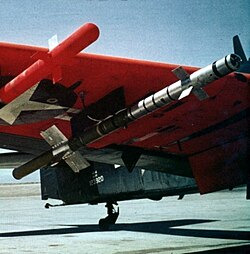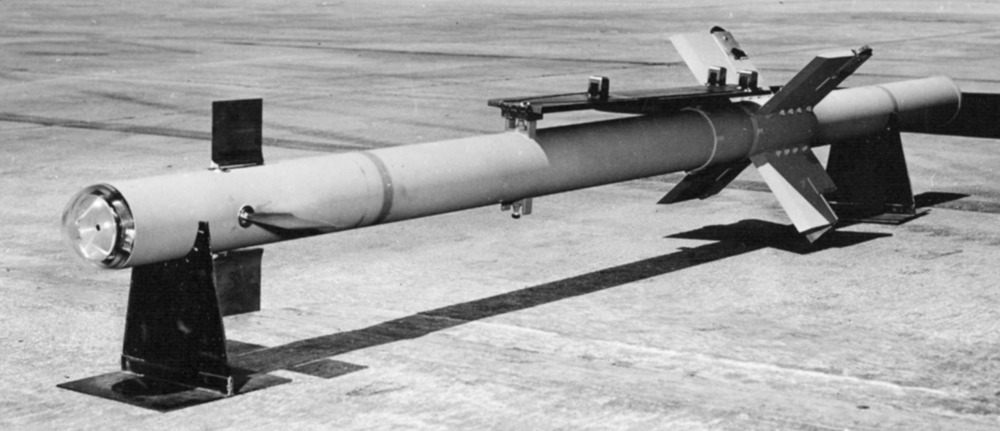Interestingly though that suggests the UK bought AIM-9H but I can’t turn up any evidence of that.
aim-9a did have rollerons, should look somewhat like this:

the extension at the rear is detachable before flight, and idk why the fins are not parallel on the upper photo
Unlike the magic 1/2 where the tail section can spin, they had to test which configuration was optimal and the only way they did things back then was to launch and observe at least until the late 60s where they started aiding their efforts with computers.
Dont most Aim-9s strictly speaking have LOAL?
though its more like yeeting a missile in a general direction and the seeker will find something hot to lock onto in that direction?
No, they like to be locked before launch.
No. First Aim-9 with LOAL - Aim-9X. but this loal limited to front hemisphere. In block II it have full 360 degree.
Boresighting a sidewinder =/= LOAL, yeah you can just fire the sidewinder head on and hope it locks what’s in front of you, but that’s a far cry from a LOAL system.
It’s from a museum so who knows how accurate it is lol
So normal 9x has iog? That would make sense as it has the same seekerhead as asraam, which is just copy paste 9x seekerhead
It would probably be more accurate to say that the AIM-9X has a copy paste ASRAAM seeker, seeing as the seeker was originally developed for ASRAAM.
I’ve also seen some speculation that while the seeker head itself (sensor, gimbal, etc.) is common, ASRAAM has I significantly larger electronics section (on account of the increased diameter) so may have more processing power available to track the target and deal with countermeasures.
It’s not though, the -9X reuses the AIM-9Rs seeker, which itself is an outgrowth of the AIM-95’s alternate “Electro-Optical” seeker.



First focal plane array seekerhead itw?
I can’t say so authoritatively, and the AIM-9R never saw service. So it doesn’t count.
Have you got a source for that being the case? The AIM-9R used an optical imaging seeker (in or close to the visible light spectrum), rather than the MWIR IIR one used on ASRAAM and as far as I know AIM-9X. A major limitation of the AIM-9R’s seeker was that it didn’t work at night, so I would be very surprised if the AIM-9X used it. Also secondary sources seem to agree that AIM-9X uses ASRAAM’s seeker.
Apparently the designation for the -9R’s seeker is the WGU-19/B (Pave Prism), and was registered in 1990.
https://nationalstocknumber.info/national-stock-number/1427-01-317-3161
Could be conflation of alternate configurations for tender of the AIM-9X program?
As an entry for the WGU-51/B also exists separately listed for the -9X. but may have seen revision post-facto.
Why is it smoky, did it use new motor?
You do get that they are called “Smoke-Less” Motors, not “No-Smoke” Motors, right?
Basically under some atmospheric conditions the inability to absorb sufficient excess water into the air due to higher altitudes (lower pressure and temperature) causes the chemical reaction to shift the equilibrium and favor the production of Aluminum oxide, which is what actually takes the from of the fine white particles that can be seen as “smoke”.
The AIM-9X datasheet would suggest that it uses, or is at least based on, an in-production seeker. That would be the ASRAAM seeker unless you are aware of another 128 x 128 IIR seeker being produced by the US at the time? And as I noted, various secondary sources/articles say the seekers are the same between AIM-9X and ASRAAM
Spoiler

Is there any evidence that AIM-9X used AIM-9R’s seeker? As I noted the AIM-9R seeker did not work at night, so I doubt they would have used it for AIM-9X
Spoiler
Sidewinder: Creative Missile Development at China Lake by Ron Westrum

Declassified MOD report:

Predicasts Technology Update Volume 48:

Strategic Digest Volume 20 Part 2

That’s still better than soviet/russian/ukranian focal plane ir sensors which were only offered for export customers and still didn’t enter service yet.
Also, where did you get that the aim-95 used a electro optical sensor? Would like to read up on that


